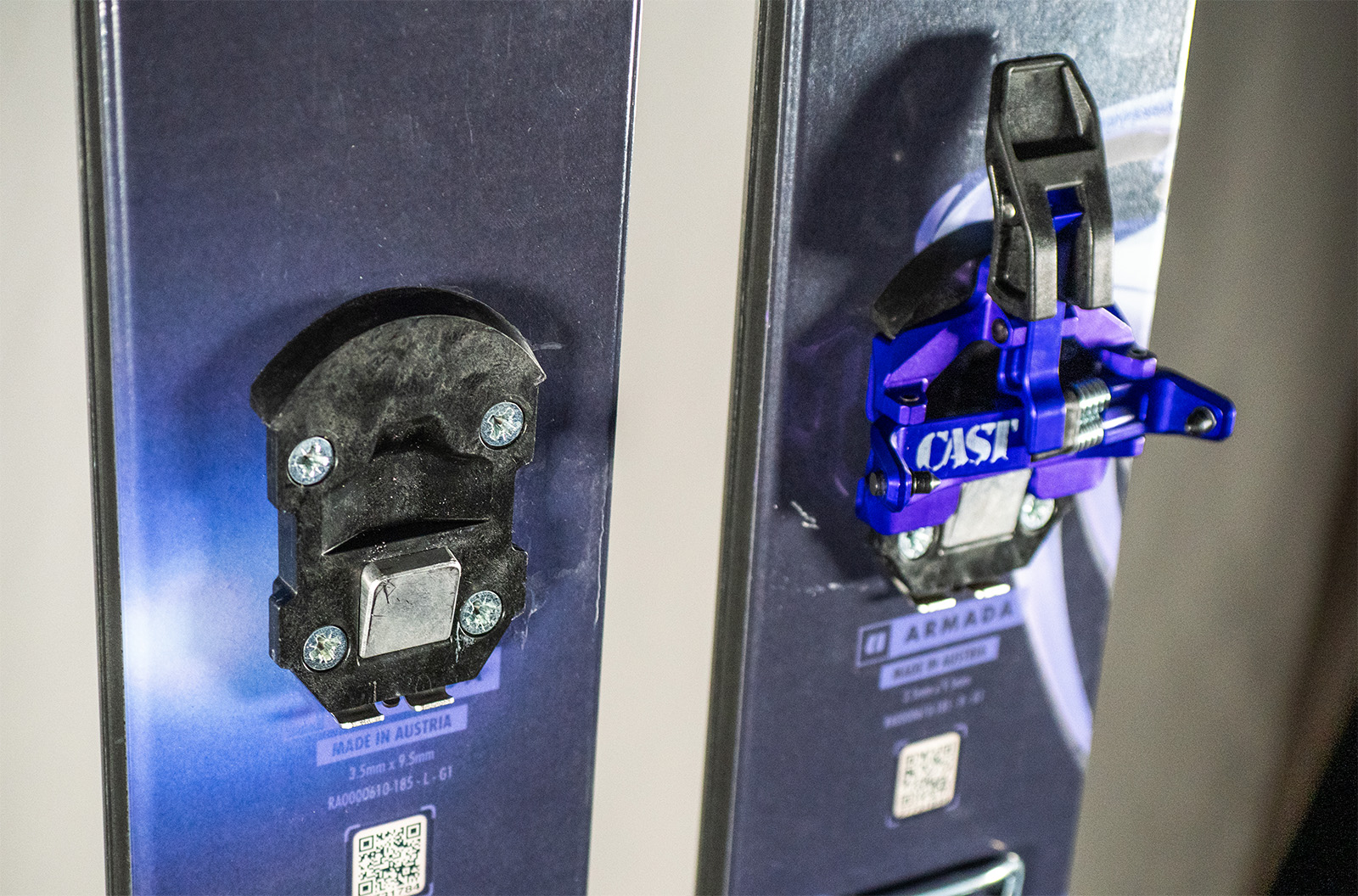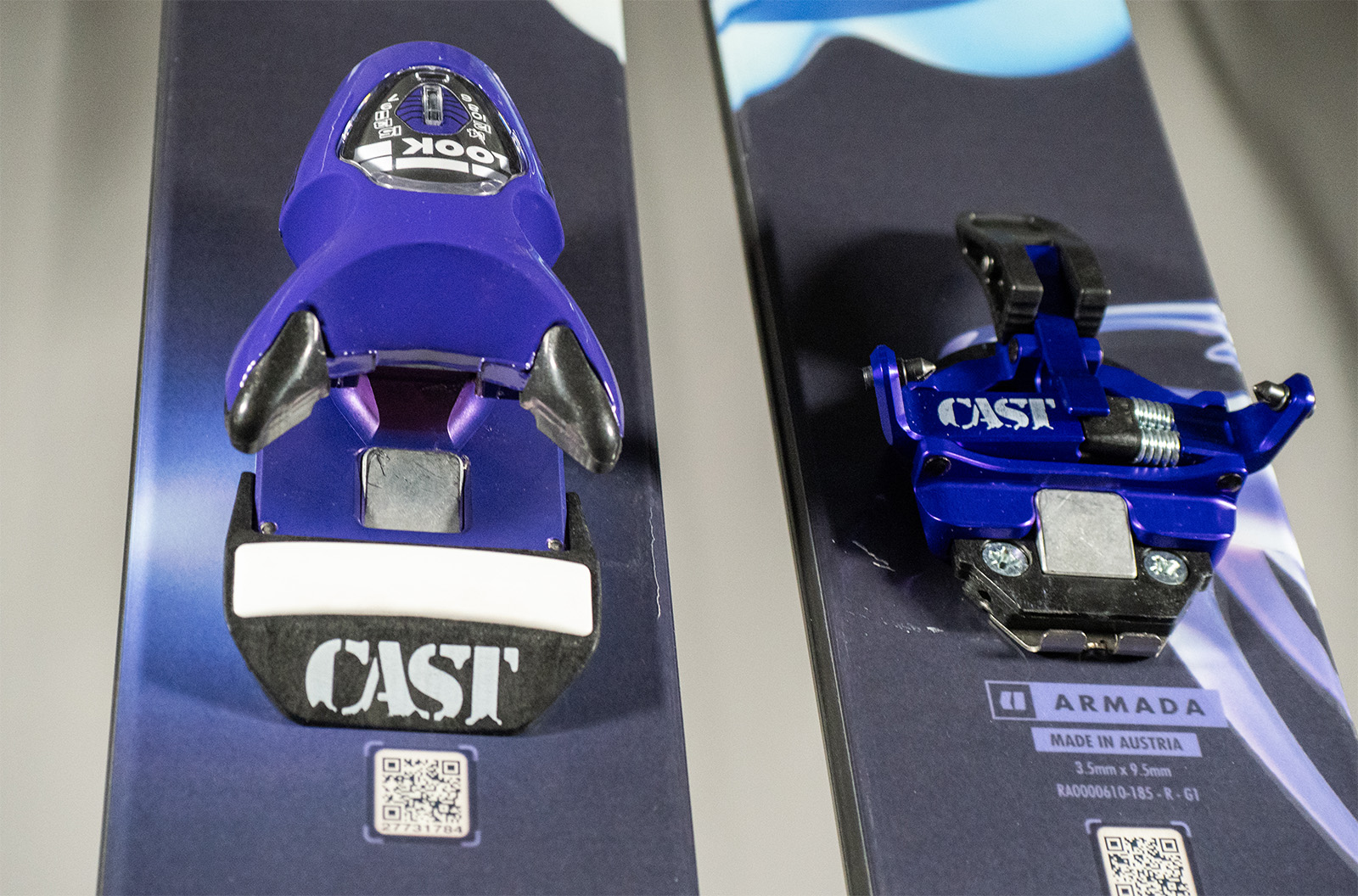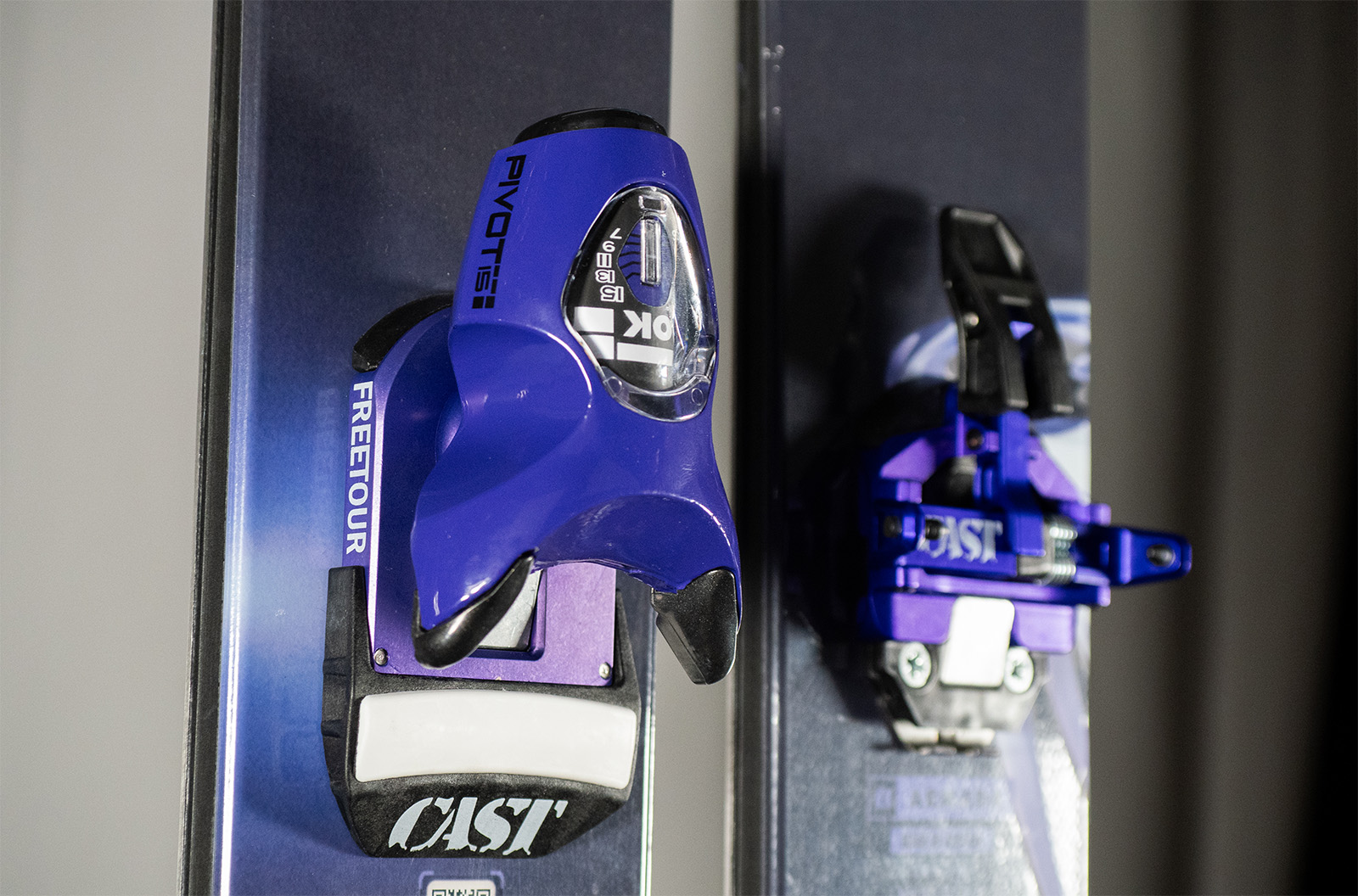2024-2025 CAST Freetour 2.0 Pivot 15
Release Value Range: 6-15 (8-18 “Pivot 18” version available)
Available Brake Widths: 95, 105, 115, 130 mm
Available Crampon Widths: 90, 100, 110, 120, 130 mm
Climbing Aids: 0, 8, 12°
Lateral Elastic Travel (toe): 45 mm
Vertical Elastic Travel (heel): 28 mm
BSL Adjustment: 20 mm
Blister’s Measured Weights (per binding / per ski):
- Downhill (Alpine) Toe Piece: 412 g
- Uphill (Tech) Toe Piece: 87 g
- Toe Plate + Heel Piece + 115 mm Brake Unit: 933 g
- Total Weight On Ski While Skinning: 1016 g
- Total Weight On Ski While Descending: 1341 g
- Total System Weight: 1428 g
MSRP: $779.95 USD

Intro
CAST Touring was the first company to create a binding that let you skin uphill using a “tech” or “pin” toe akin to lightweight touring bindings, but then ski back down in a setup with all the downhill and safety benefits of a standard alpine binding.
Their platform utilized a standard Look Pivot 15 or Pivot 18 alpine binding and CAST’s custom hardware. The resulting system allowed you to swap the alpine toe piece for a tech toe piece, and it added heel risers and brake locks to the heel unit for uphill travel.
The Idaho company has continued to iterate on this concept over the years, and their new Freetour 2.0 system represents the latest evolution of the CAST platform. We first got our eyes and hands on the Freetour 2.0 at Blister Summit 2023, where CAST co-founder, Lars Chickering-Ayers, brought a prototype and joined our panel session on the past, present, and future of binding design. If you haven’t already, you can check out the video of that discussion here:
Now, the Freetour 2.0 is available for purchase, and we started spending time using it last season. We discussed our initial impressions of the platform in our 24/25 Winter Buyer’s Guide, but while the snow once again starts to blanket the backcountry, let’s take a closer look at its design.
CAST Freetour 2.0 Design Overview & Options
As with prior iterations, the Freetour 2.0 consists of a modified Look Pivot 15 or Pivot 18 and CAST’s custom hardware. It is not compatible with the Look Pivot 12 or Pivot 14 variants, which feature a different toe piece.
CAST offers a few different options for purchasing and putting together this system. If you need a brand-new setup, you can buy the whole Freetour 2.0 system, including the Look Pivot 15 or 18 parts, for $779.95.
Alternatively, if you already have a pair of those Pivot bindings and want to convert them, you can get the Freetour 2.0 upgrade kit (MSRP: $364.95), which includes CAST’s hardware and allows you to convert your Pivot 15 or 18 into the Freetour 2.0 system.
You can also purchase the “Freetour 2.0 Second Ski Kit” (MSRP: $74.95), which gets you the toe base plates and heel assemblies for the climbing risers / brake lock. This would allow you to use a single set of Freetour 2.0 toe pieces across two pairs of skis; you would still need to have two pairs of Pivot 15 or 18 heel pieces, since those are drilled into the ski, not swappable via base plates like the toe pieces.

CAST notes that “Integration of the CAST® Freetour Upgrade Kit with a LOOK® PIVOT™ binding will void any warranty or manufacturer’s or seller’s liability on the part of Group Rossignol USA, Inc. or Look Fixations SAS. Any such recourse shall be directed to CAST.”
On the descent, the Freetour 2.0 works just like a regular Pivot 15 or Pivot 18, albeit with CAST’s mounting hardware, AFD, and heel risers / brake-lock unit.
On the ascent, you remove the alpine toe piece via a quick-release button on the base plate, stash that in your pack, jacket, etc., and then slide on the touring toe. You can then flip the Freetour 2.0’s brake lock back toward the tail of the ski, stomp down, and the heel piece’s brakes will stay up while skinning. The Freetour 2.0 also has two wire climbing aids that you can flip up to go from a flat skinning position to 8° and 12° of heel rise.
At a broad level, that’s all very similar to the original Freetour and prior-generation CAST bindings. But let’s dig into what’s changed with version 2.0.
Design: Toe Pieces
This is where you’ll find most of the differences between the Freetour 1.0 and Freetour 2.0 systems.
With the second version, CAST overhauled their base plate (the part that’s mounted to the ski) and how it attaches to the Freetour 2.0’s alpine and tech toe pieces.
The Freetour 1.0 toes attached to a metal plate with four shoulder screws; those screws aligned with slots on that generation of toe pieces (see our review of version 1.0 for more details). You’d pull the toe back toward the heel and lift the toe up and off the plate when swapping.
For the Freetour 2.0, CAST created a more compact base plate that secures to the toes via a spring-loaded metal “button.” Depressing that button allows you to slide the toes off and on from the tail end of the ski. Once the toe is in position, the button snaps into a void in the toe piece to prevent it from moving on the plate. The rails of the plate prevent the toe pieces from sliding off toward the tip of the ski (i.e., the direction where the most force would be going with a ski boot pushing on the toe piece).




As before, the Freetour 2.0 system uses CAST’s own tech toe for uphill mode, and it functions very similarly to most other tech / pin bindings on the uphill; CAST does not recommend skiing downhill when using their tech toe (aside from, say, brief downhill portions of undulating skin tracks). You cannot lock your boot’s heel down when the Freetour 2.0’s tech toe is installed, due to the tech toe positioning your boot further forward / toward the tip of the ski.
So far, the Freetour 2.0 has been extremely easy to transition. We still need more time with it, particularly to test potential icing complications, but so far, it’s easy to swap the toe pieces with one hand. The rails of the toe plate and different toe pieces also create a better-sealed system than previous iterations; the latter had small openings for the shoulder screws which were exposed to snow.




The Freetour 2.0 tech toe also includes a crampon slot that’s compatible with “Dynafit-style” ski crampons.
Lastly, CAST includes with the Freetour 2.0 system AFD (“Anti-Friction Device”) plates to work with all the major ski boot sole norms: one for both Alpine (ISO 5355) and GripWalk (ISO 23223), and another for more rockered Touring soles (ISO 9523). You can swap the AFD plates via two metal bolts on the underside of the alpine toe piece’s base plate.
Design: Heel Pieces
Not much has changed here. The heel unit is a simpler affair than the toe — it’s essentially a Look Pivot heel piece that’s mounted over CAST’s brake-unit assembly.
The latter requires two additional holes drilled in front of the heel piece, but that aside, the mounting pattern of the Freetour 2.0 is idential to a regular Look Pivot 15 or Pivot 18. CAST includes a Heel Hole Template with each Freetour 2.0 to aid in the mounting process.

The brake assembly consists of a plastic block (to match the height of the regular heel piece), along with a lever to lock the brakes in uphill mode and two wire climbing risers for steeper skin tracks.
Weight & Comparisons
In general, the heaviest bindings of today offer better overall downhill performance and more reliable release / retention characteristics than the lighter alternatives. While there are nuances to that generalization (especially when comparing bindings around the middle of the weight spectrum), it’s a common compromise among ski-touring gear.
Given that it’s basically a Look Pivot in downhill mode, it’s not surprising that the Freetour 2.0 system is one of the heavier touring bindings on the market. That said, the Freetour 2.0’s on-ski weight in uphill mode is very similar to its two main competitors, the Marker Duke PT and Salomon / Atomic / Armada Shift2.
All three of these “hybrid” bindings promise the downhill performance and release characteristics of a regular alpine binding but let you skin uphill using a tech toe. And all of them are a lot heavier than touring bindings that don’t provide alpine-binding downhill performance.
For reference, below are our measured weights (per individual binding) for a number of downhill-oriented touring bindings we’ve tested.
595 g | Plum Karibou 12 Stopper
626 g | Dynafit Rotation 10
630 g | Fritschi Tecton 13 (stated weight)
639 g | G3 ION 12
670 g | Marker Kingpin M-Werks 13
775 g | Marker Kingpin 13
926 g | Salomon / Atomic / Armada Shift2 13
1016 g | CAST Freetour 2.0 Pivot 15 | Uphill Mode
1074 g | Marker Duke PT 16 | Uphill Mode
1383 g | Marker Duke PT 16 | Total System
1428 g | CAST Freetour 2.0 Pivot 15 | Total System

Some Questions / Things We’re Curious About
(1) CAST’s Freetour 1.0 system was one of the most reliable touring bindings we had used — in terms of downhill performance and long-term durability — so does that still hold true of version 2.0?
(2) How does the Freetour 2.0 compare to the Marker Duke PT and Salomon Shift2 in terms of downhill performance, long-term durability, and overall ease of use when skinning, transitioning, and skiing?
Bottom Line (For Now)
As we’ve noted before, it’s an exciting time to be a backcountry skier — especially when it comes to your binding options. In the Freetour 2.0, CAST has continued to refine their take on a durable, downhill-oriented touring binding that provides alpine-binding performance on the way down while letting you get back up the hill via a tech toe.
We’ll continue to test the Freetour 2.0 this season and, once we’ve spent enough time comparing it to the other options on the market, we’ll chime in with our Full Review.


Thanks, very interesting.
In case someone wants to put these on very wide ski:
I just mounted the setup with a 130 break on a DPS Lotus 138 (latest generation but the discontinued 182). I fits with minimal bending. Anything wider will require heavy bending.
Isn’t that push button a bit concerning? What if water freezes under and the button can’t be pressed? I really like that design more than the v1 as it won’t require the same perfect alignment of the screws for the front binding, and mechanically much better, also possibly more resilient to icing in normal situations as the v1 screw slots would get iced fairly easily, but nothing that a bit of brute force would not unlock in seconds. But if that v2 button locks up with ice under, I don’t see how brute force would work as the ice has nowhere to go even if fractured, also hitting a button is quite different from hitting the whole assembly.
And the reverse could be possible? Ice or compacted snow under the toe could release it? I appreciate that in downhill mode, the boot would hold the toe piece in place even if this were to happen, but if it froze in the unlock position and you released it in a crash, could the toe piece go yardsale-ing with you?
The “Freetour 2.0 Second Ski Kit” works with 12/14/15/18 heels.
All the Pivot heels will work with the brake retainer/climbing riser assembly. The toe mechanism only works with the metal 15/18 pedestal/housing.